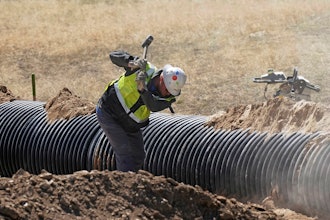In the last couple years, the American economic outlook has been bleak. Industries of all shapes and sizes have faced enormous challenges as they’ve struggled to adapt to the current fiscal climate. And nobody would disagree that one of the industries hit hardest – both by the downturn and by ever-growing competition from overseas companies - was manufacturing.
Despite the hard knocks, manufacturing is leading a dramatic resurgence. In fact, according to the latest Manufacturing ISM Report On Business® issued by the Institute of Supply Management, activity in the manufacturing sector has been expanding for 19 consecutive months, as of February 2011. It’s one of the few industries demonstrating consistent growth.
Manufacturing accounts for about a fifth of U.S. economic activity, so it can't carry the recovery on its own. But at a time when consumer spending, the housing market and other sectors are still struggling, it offers a glimmer of hope for better days to come.
The current optimism notwithstanding, recent struggles serve as a harsh reminder that continuous improvement is the only way to succeed over the long term. Complacency means missed opportunity; innovation is the only means of sustainable growth. As the industry moves forward, manufacturers would be wise to keep in mind the lessons of the recent hard times to avoid repeating similar mistakes in the future.
This article will examine the current state of American manufacturing, evaluate lessons one company learned while emerging from economic hardships, and present ways other manufacturers can recognize and overcome obstacles for long-term industry success.
The American Manufacturing Resurgence
The American manufacturing industry is growing, and it has been for well over a year.
The latest Manufacturing ISM Report On Business®, February 2010, states the following: “February's report from the manufacturing sector indicates continuing strong performance as the PMI registered 61.4 percent, a level last achieved in May 2004. New orders and production, driven by strength in exports in particular, continue to drive the composite index (PMI). New orders are growing significantly faster than inventories, and the Customers' Inventories Index indicates supply chain inventories will require continuing replenishment. The Employment Index is above 60 percent for only the third time in the last decade.”
According to the National Association of Manufacturers (NAM), the United States is still the world’s largest manufacturing economy, producing 21 percent of global manufactured products. Japan is second at 13 percent, and China is third at 12 percent.
And not only is the industry itself growing, but public opinion of its importance within the U.S. also remains high.
A recent survey focusing on the American public’s opinions on the industry and its future, conducted by Deloitte, shows a nation that believes manufacturing is a core component of our economic well-being, with over 78% of those surveyed saying it is “very important to our prosperity.”
However, the nation as a whole is still concerned about the future of the industry. For example, while perceptions of manufacturing jobs are improving, only 30% of respondents to the Deloitte poll said they would encourage their children to pursue a manufacturing career. Clearly, long-term growth is not without its obstacles.
One Company’s Struggles and Triumphs
The economy has devastated many manufacturers over the past several years, and newspapers still headline story after story about plants closing their doors. But as the ISM data suggest, just because these companies are down doesn’t mean they’re out.
One of the companies hit hard by the economic collapse was 125-year-old Cincinnati Milacron, the only manufacturer of plastics injection molding processing equipment still based in the United States. The company was forced to file Chapter 11 bankruptcy in 2009.
Now, this might sound like just another sad story about the industry. But the ending is much different.
While 75% of companies that enter bankruptcy never emerge, Milacron returned to profitability within one year, with a balance sheet that reflects $500 million less in liabilities and 80 percent less debt. The company didn’t just survive; it’s now investing in the business in ways it hadn’t been able to do in over a decade.
Key Attributes to Supporting Recovery
While Milacron’s story is remarkable, it’s not that unusual. The company represents the innovation and determination that have been typical of American manufacturing for over two centuries. With bankruptcy behind it, Milacron leadership took time to critically evaluate and embrace its mission and value proposition, enabling it to emerge stronger than ever.
- It may sound simple, but a “can do” attitude is one of the most important components of weathering difficult times as a company. Management and employees must recognize the need to face adversity head on and overcome it while laying the foundation for future success.
- Another trait companies must embrace is a renewed commitment to customers. It’s easy to let internal needs trump those of customers when times get tough. But that’s the time it’s even more crucial to focus on providing customers with products, services and technologies to help them survive and thrive.
- Focusing on technology advancements is another important part of maintaining a company’s value proposition. For example, Milacron had long been a leader in many key technologies ranging from all-electric machine design and multiple-component molding to complete manufacturing systems. With overseas competition growing, the company recognized the need to intensify its innovative efforts. It established an infrastructure for making continuous improvements to its platforms, products and services to provide customers with ever greater value.
- Maintaining and enhancing brand reputation is additionally important. Milacron sought to create a true differentiation from competitors by focusing on customer relationships as well as intangibles such as brand and industry leadership. The company also emphasized its history of innovation and “firsts,” which helped reinforce its longstanding solid reputation to customers and business partners.
- The final, and quite possibly most important, key to success lies in a company’s people. A manufacturer should never underestimate the importance of a well-respected, experienced leadership team and devoted, highly-competent employees. They are every company’s most important resource, and should always be valued as such.
Lessons Learned from the Recession - U.S. Competitive Advantages
Beyond specific company attributes that support recovery, there are philosophical lessons to learn.
Most notably, American manufacturers must recognize that, while the U.S. still has major competitive advantages over many overseas companies, that window is closing quickly. Our country’s manufacturers must capitalize on this advantage as best they can while it lasts, because the technologies and the skills of overseas workforces are quickly advancing.
Among the American advantages is the ability to partner with other domestic companies. Despite lower upfront prices, sourcing from cheaper overseas companies often has many unexpected costs in terms of quality, delivery and efficiency.
Meanwhile, in America, the recession has created a tremendous amount of capacity. A strong, permanent U.S. presence enables speed to market and immediate customer service with parts and technical support that overseas competitors can’t match.
A customer’s biggest cost, after all, is downtime. American manufacturers have the performance, a full stable of capabilities and proximity to U.S. customers that can help other domestic manufacturers keep their machines running.
These are among the reasons having a North American supply chain is a much bigger advantage than many manufacturers previously thought.
Obstacles Still Facing American Manufacturers
American manufacturers still have many hurdles to clear on the way to sustainable growth. Some of them, manufacturers can influence; some of them, they cannot. Either way, recognizing these challenges is an important part of planning to overcome or avoid them.
One of the primary obstacles that face manufacturers today is the current difficulty of obtaining capital. Banks remain restrictive with their money. If companies had more access to capital, they’d be better able to invest in their own businesses.
Uncertainty in policies is also a significant challenge. In election years, many manufacturers feel they must wait and see the results before making big decisions.
Beyond lobbying and encouraging the voting public to support legislation that favors manufacturers, many of these obstacles lie outside of manufacturers’ control.
As such, it’s important to recognize and capitalize on financial opportunities when they present themselves, such as research and development tax credits or increased access to capital.
Education Advocacy: Necessity of Attracting and Retaining Quality Employees
The challenge of recruiting and retaining a talented, driven workforce is one area where manufacturers can make immediate impact, both collectively and individually.
As stated earlier, only 30% of respondents to the Deloitte poll stated they would encourage their children to pursue a manufacturing career. This presents an urgent need for manufacturers to advocate technology educations and attract future generations of advanced thinkers.
To drive growth, manufacturers must strive to change the public perception of the American manufacturing industry. Gone are the days of dark, dismal factories, but those images still permeate the culture, driving up-and-comers to more ”glamorous,” white-collar professions.
Industry leaders must present manufacturing jobs to the next generation for what they really are – good-paying, family-supporting careers involving advanced technologies. As manufacturers struggle to meet increasing demands, they must still dedicate resources toward advocating technical education, so that the workforce of the future is fluent in automation and other technologies critical to our success.
Energy Efficiency: Necessity for Continued Technological Advancements
Additionally, limited fossil fuels present a significant obstacle and necessitate the push toward more energy-efficient manufacturing solutions.
Companies such as Milacron are doing a lot to address this need by devoting more resources toward earth-friendly technologies. In addition to implementing product lines that focus specifically on energy efficiency, Milacron is also making a strong effort to help customers retrofit upgraded technology into existing machines.
Not long ago, hydraulic machines were the best available. Now, all-electric versions offer big gains in energy efficiency and precision, significantly reducing operations costs while helping manufacturers become less dependent on oil.
Such technological advancements present one of the biggest ongoing opportunities for American manufacturers. Realistically, production that can be done in a low-cost country has probably already been sourced there. This means that production in the U.S. – some of which has been brought back from low-cost countries – is here because America has capabilities and technology that can’t be matched abroad.
Manufacturers must do everything in their power to continue being leaders in technology advancements, efficiency and quality.
Collective Industry Support: Necessity for Helping Each other Make it in America
The final major obstacle of American manufacturers must address is the need for industry leaders to pull together to help each other succeed.
One of the ways Milacron is rallying partnership among American manufacturers is through its “Helping You Make it in America” awareness campaign, an effort focusing on the challenges and opportunities faced by our country’s vital manufacturing sector.
Manufacturers must band with each other, and together highlight the advanced technologies, strategic partnerships, advocacy, civic support and other keys to success in today’s competitive global market and recovering economy.
With today’s tight resources, lean operations and challenging demands, our country’s manufacturers need more support than ever from their supply partners. For its part, Milacron works closely with customers not only to develop new technologies that meet emerging needs, but also to maximize the value of investments they’ve already made – streamlining processes, increasing equipment utilization, reducing costs and optimizing performance.
As statistics indicate, the American manufacturing industry is definitely in a much better place than it was two years ago. But as history shows, manufacturers who fail to examine past mistakes are destined to repeat them.
American manufacturers must continue to evaluate the lessons of the last few years, and apply them in the days ahead. By doing so, and banding together to support each other in this endeavor, the U.S. manufacturing sector can continue to carry its current success into the future in a sustainable way.
Author Bios:
Dave Lawrence serves as President of Milacron’s Plastics Machinery Injection/Extrusion and Mold Technologies. He is knowledgeable source on global industry issues and a spokesman for the American manufacturing resurgence. Having risen through the ranks over 30 years from his start as a toolmaker, Lawrence has an unparalleled understanding of the American manufacturing industry, its people and its concerns.
Glenn Anderson serves as Senior Vice President of Global and Strategic Accounts for Milacron. With extensive industry experience, Anderson knows what matters in manufacturing and works to help customers improve productivity, cut costs, increase energy efficiency, eliminate scrap and reduce cycle times.


















